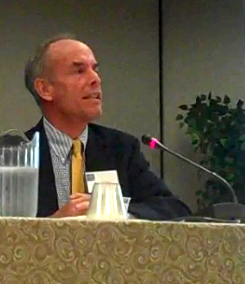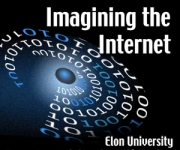Posts Tagged ‘Rainie’
CONCLUSIONS: ‘What We Don’t Know About the Future of the Internet’ Rainie and morning plenary respondents finish the session
 The panelists answered questions about finding ways to satisfy desires of people to share freely but somehow pay an appropriate price for the information they gain. “Most in my generation won’t want to pay for things because they are used to things being free,” Gyllenhaal said. “Young people will pay for things we use. I guarantee young people would pay for Facebook. It has become that important for us.”
The panelists answered questions about finding ways to satisfy desires of people to share freely but somehow pay an appropriate price for the information they gain. “Most in my generation won’t want to pay for things because they are used to things being free,” Gyllenhaal said. “Young people will pay for things we use. I guarantee young people would pay for Facebook. It has become that important for us.”
Andrew McLaughlin came into this discussion in support of the principles many, including Chris Anderson (author of “Free: The Future of a Radical Price” and originator of the “Long Tail” idea in Internet economics), have brought to the forefront of the discussion of Internet economics. “Free doesn’t really mean ‘free,’” he said. “We have lots of media now that is free to the end-consumer in exchange for attention or something that benefits someone else. There will be things you are asked to pay for and things that third parties are asked to pay for.” He added it is important to find ways to properly “vindicate intellectual property rights” online and also address privacy, anonymity and authentication in the right way. “I find the ‘free’ debate to be kind of dissatisfying,” he said. “Free to the end-user still leaves you a broad way to pay for things.”
Lee McKnight noted that the issue is complicated. “It’s not just an issue of free and for-pay, there are barter arrangements that come into play as Internet governance has been progressing in these historic days,” he said. “Economic and competition policy will come to the fore… This is a ripe area for policy analysis and discussion at IGF in Egypt and over time as we continue to grapple over challenges.”
Rainie was asked about education and the Internet as an audience member noted how far behind education is in implementing the advantages of the Internet. “Participation matters,” he noted, saying it has been shown that students enjoy the ways in which they can be more active participants in their education when they can go online in classrooms.
McLaughlin chimed in. “The federal government is a disaster when it comes to using these new tools,” he said, noting that it blocks employees’ use of social networks.
“I hope that people less freaked out by these networks and systems will start running things,” he said, adding that every government employee should have a home page offering information they want to share and affording them the ability to collaborate with others in government. “That would drive a culture change that would be unstoppable,” he said, “and you would get the efficient task-oriented government we are trying to achieve.”
-Janna Anderson, http://www.imaginingtheinternet.org
What We Don’t Know About the Future of the Internet – Part II
 Lee Rainie, Pew Internet & American Life Project:
Lee Rainie, Pew Internet & American Life Project:
What kind of Internet will we have?
Rainie noted the expectation of a “broadband tsunami” but added that “there are two public policy disputes in the realm of Internet architecture where the outcome will determine how widely that tsunami washes over things.”
The two architecture points he illuminated are the broadband issue and the question of how best to make the current Internet architecture more secure and robust, scaling it up to meet escalating needs.
Regarding broadband, he said the latest Pew survey (Sept. 14) shows 77 percent of American adults use the Internet and 63 percent have broadband access at home. This ranks the United States somewhere between 15th and 25th among advanced nations in broadband penetration, depending upon which global study of uptake you choose to cite.
“Whatever the United States’ place in the world rankings,” he said, “it is clear that 27 percent of Americans do not have high-speed connections and there is substantial policy ferment about the best way to bring broadband connections to rural areas and to those with relatively low household incomes.”
Rainie said there is hope in mobile connectivity for closing this digital divide somewhat because the uptake of these devices is more even across regional and economic categories. “But,” he added, there’s a question “about whether phone access to the Internet is as important and as useful as access on computers in terms of experience and personal satisfaction.”
Rainie also touched on the issue of network neutrality, which he described as “whether providers can offer premium media content over their networks and give that content preference to some digital material in exchange for charging higher prices to recoup their investments, or whether all digital material, from e-mails to medical records to high-resolution movies should be treated equally by the network as it currently is.”
When he addressed the future of Internet architecture, Rainie said there are four key problems with the current Internet:
Security: “The ‘start-over’ planners would love to build a new system that would do a better job of authenticating people and their computers in a way that would keep hazards at bay,” he said.
Mobility: “The ‘start-over’ folks hope to create a new system to assign Internet addresses” in the many varied devices in the Internet of things,” he noted.
Instrumentation: “The ‘start-over’ group would like to build something allowing all pieces of the network to have the ability to detect and report emerging problems due to traffic overloads, replicating worms” and other difficulties,” he explained.
Protocols: “These traffic-flow concerns also prompt ‘start-over’ architects to want to structure better traffic routing agreements between Internet service providers that would allow them to collaborate on advance services without compromising businesses,” he said.
-Janna Anderson, http://www.imaginingtheinternet.org
 Lee Rainie, Pew Internet & American Life Project:
Lee Rainie, Pew Internet & American Life Project: 